Electric Cars Are Dragged To The Bottom Of The Auto Corporation?
One of the critical moments in the future of the automotive industry will be electric cars. In Forbes, this view has already been discussed in a specific context. A possible way out of this crisis will be described in this article based on the inevitable condition for the future electric car – energy saving.
Is it all so gloomy for the future? Of course, now you can often hear that electric cars are not economically viable because of their extreme simplicity of design. This fact is introduced as one of the main ones in the retardation of the development of electric vehicles in the world. Of course, this is not unreasonable.
Obviously, is the ICE with a gearbox a complex mechanical-hydraulic system? The number of parts with special treatment and the complexity of manufacturing with different resource lifetimes simply cannot be compared with the electric motor and battery. The first hybrid drive from Toyota can be considered the apogee of the constructive complication. Not for nothing, after the release of this technology, the Japanese company made the patents on this technology free for all auto manufacturers.
The problem of an excessive complication of engines has also become relevant for conventional ICE in recent decades.
Car manufacturers can be understood since these improvements are mainly due to accepted environmental standards, but there are still stricter standards ahead. Separately, it is worth mentioning that the improvement of engines for eco-standards does not pass for free, and selects part of the profits on each car.
In general, the seriousness of the problems arising in the automotive industry can be devoted to a separate article with a lot of facts, most of which will be difficult to understand for a person who is not related to the industry.
The text is very voluminous and therefore I will give some highlights.
“One of the concepts explaining the prospects for the development of the automotive industry under the name of” fundamental structural changes “, disputes the assertion underlying the old concepts,” she denies the stability of the technology. For its supporters, the events of the late 70s marked the beginning of a new era, an era of rapid growth in the need for technological innovations and the economic return from them. Completely new types of power plants, means of transport, new organizational structures and management systems, radically different from the existing ones, promise to put companies with technological leadership in an advantageous position. ”
- “In this sense, the situation in the automotive industry is beginning to resemble the one that developed at the early stages of its development, when the production technology of the product was rapidly changing and those who introduced major functional innovations acquired significant competitive advantages. If such a process of “rejuvenation” of the automotive industry really happens, then in the history of the industry there will come an amazing period of the diversity of constantly developing technologies. ”
The study of this article gives us a very clear understanding of the death of Detroit and the problems of GM. It should be noted that in other continents, automobile corporations also play a significant role, and experience similar problems.
So what are the main outlets for auto-concerns in connection with the current situation?
- To expand the range of services (entertainment, navigation, etc.).
- To expand the number of related products (bicycles, clothing, shoes …).
- Expand the range of possibilities of use (amphibiousness, and the combination of non-typical functions).
1. Solutions in its format are recognized by VW as the most promising.
Probably the most obvious example of the mechanism for using this principle are Tesla cars, so the solution, in this case, is not very original. In general, the development of information services can still give a certain part of the profit in the implementation of the concept of communicating cars through special devices, but such a “wi-fi on wheels” is probably more needed not by the client, but by second and third parties. All the same, it is difficult to imagine the mass of car owners who want to spend some of the energy and computing power of their personal vehicle absolutely free, so without incentive programs, there is clearly no cost (perhaps such encouragement will resemble mining of cryptocurrencies).
2. The method of expanding profits – selling under the brand is absolutely not typical products.
This method has a very extensive list of user options, and such that it is not even possible to answer that in this case is the main product, and what is additional.
In Asia, traditionally focus on electronics. So Toyota makes the home robot “Kirobo Mini Robot” – a kind of “Tamagotchi” for adults. Honda stubbornly modifies the Asimo robot.
In Europe, everything is more diverse.
Then immediately recall the company, Lamborghini. Releasing tractors and sports cars is a really strong move (and it was done a long time before the mass popularity of hanging a “brand” on everything that could be earned). The first city SUV (link) in the same company did.
And of course Ferrari.
The percentage of non-car profits for this Italian company in 2016 was not less than 30 and consisted of clothing sales, amusement park profits and other types of business.
VW differs from everyone in its … sausages (part 199 398 500A). This branded product has been produced since 1973 and is popular, despite the fact that the recipe of cooking was ruled only once. The company also produces several types of sausages and cheese.
- In the previous article, I already mentioned BMW’s plans to start building covered bicycle lanes in China. The plans of their British colleagues are more modest – just the construction of a high-rise building in the center of Miami called Aston Martin Residences.
For now, the responsibility of the car company is limited to interior design and the design of the fitness center and spa, and the rest is done by hired contractors. The project started in 2016, and promise to finish the work by 2021.
Especially worth noting is the Design Porsche division. Glasses, headphones, laptops, clothes and more under the brand of a car brand for a buyer is a really strong move.
- BMW, on the contrary, produces more predictable non-automotive products – motorcycles, as well as quite strange, like bobsled carbon sleds.
Rolls-Royce develops, manufactures and maintains aircraft engines, gas turbine plants and ship propulsion systems. - MINI – manufacturer of a line of clothing and accessories. Shirts, sweatshirts, t-shirts, jackets, and even shoes — all this can be bought under the MINI Cooper brand.
The production of refrigerators can probably be considered the most frequent manifestation of associated car production of manufactured goods. International Harvester, ZIL, and many Asian brands produce refrigeration equipment, and the Mitsubishi brand, for example, even now is a well-known manufacturer of climate control equipment.
Widely known and military products auto companies. Chrysler, for example, was engaged in the release of tanks M1 Abrams, until 1982. GM made the weapon. They produced M3 rifles and Liberator FP-43 pistols. GM did the same as the lunar rover, which probably in a certain sense can be considered an earlier launch into space of the car than Musk did.
Part of the automakers is periodically made together with the shipbuilders luxury yachts (Mercedes Benz, Bugatti, Lexus).
Among the offers of automotive companies are branded bicycles: MINI Cooper, Audi duo Sport, McLaren Venge, BMW M Carbon Racer, Porsche Bike RS, ŠKODA Kid, Mercedes-Benz Trailblazer, Shelby Cruiser, Spyker Aeroblade, and many others …
Of course, now this corporate offer looks more like a step towards PR, not production, but everything can change in the future. All the same, most of the technology from the bicycle industry once migrated to the auto industry in the early 20th century, so why with the growth in demand for energy efficiency cannot occur the reverse process.
The list goes on and on, the examples presented are only an illustration of the flexibility of auto-corporations.
As practice has shown, the transition of automakers to the release of products that are not typical for this area was not uncommon before, not such a rarity now (for example Daewoo and Samsung), and it will not be strange in the future.
Therefore, when such companies as Davison declare their desire to enter the automotive market, it no longer looks strange. At least they are at least somehow connected with electrical engineering.
- The guarantee for the development of all these giant corporations was always the opportunity to produce a complex technical product, which was not so easy to repeat in small production volumes without increasing the price. With the advent of the era of electric vehicles and hybrids, this advantage is literally melting before our eyes. Chinese companies and many others provided easy access to large volumes of lithium batteries, can now make the car no worse than those of the automotive “monsters” of the industry.
Perhaps now it is clear why, with all the problems, Tesla still not only succeeds in surviving but also expanding the number of models and production volumes?
All of the above can already be safely attributed to the already traditional methods of business development.
And now the last one, not used in the mass auto-production …
The 3rd method becomes obvious with the transition to electric traction.
In this case, amphibiousness is an expansion of supply on the market, and an excuse for the high price of a car, by analogy with crossovers – “SUVs”, which are essentially increased all-terrain vehicles. ). If you look at the development of the crossovers market, then you can see that the crossing of a conventional passenger car with a cross-country car went well. The client is “ready to pay for what he does not need 90% of the time on the road”.
Perhaps it is necessary to proceed to the next stage of the floating car?
The easiest way to realize the possibility of “swimming” in the electric car. The case of the “waterfowl” Tesl is just one more confirmation of this possibility.
Musk, incidentally, does not hide the fact that he is working on the theme of a “water-floating” electric vehicle. So according to Mask, the company is going to create an amphibious vehicle based on the Lotus Espirit car.
“We will create a car that can move underwater. He will be able to transform from a submarine into a car that can drive along the shore. We may release two or three of these cars, but not more. ”

Thus, the amphibious vehicle will resemble Bond’s car, from the movie “The Spy Who Loved Me”.
Why haven’t other companies dealt with this topic before? And here it is worth turning to the history of water-powered vehicles with ICE.
The first mass civilian amphibious car was the Amphicar 770 (Germany).

The Amphicar 770 Cabriolet is currently the only civilian amphibious vehicle in history that has not been manufactured individually but in large quantities. Created a floating machine self-taught designer Hans Triple, who began to design amphibious vehicles before World War II.
The number of military amphibious vehicles, in general, is large, but such vehicles, as a rule, did not pass into the civilian sphere.
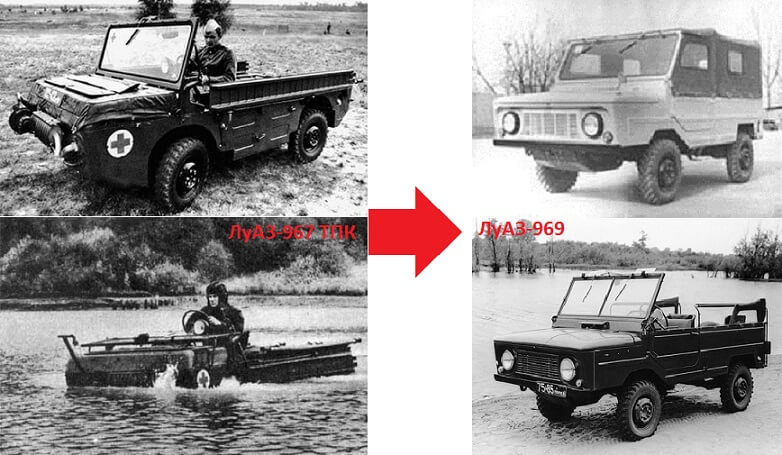
From the mass of the military, I would note the domestic LuAZ-967 TPK, which later turned into a less massive construction of the rural “SUV” LUAZ (the owners of this device were very sorry for the absence of water-floating properties, knowing its “pedigree”).
The German experience of mass auto amphibians tried to repeat in Japan.
An example of plans for a mass floating car is Isuzu Nagisa.

As conceived by the creators, this car was supposed to be an absolutely real mass solution and was designed to solve the problems of the automotive world in real time.
The concept was presented back in 1991 at the Tokyo Motor Show. The reaction of the public was stormy, and the company poured pre-orders of this model. Isuzu engineers assumed at the time that such a machine would be able to unload roads in Japan in large port cities, and would be the beginning for a whole series of boat cars for various purposes.
- The reality turned out to be more complicated … Despite the use of the technologies of the 90s, the amphibian did not get rid of the traditional flaws of the “amphibians” – slowness and sluggishness, as well as instability in the aquatic environment.
The project was curtailed and the machines could not get even those who were ready to buy them despite the identified shortcomings right at the auto show (though the story is a bit like the movie Who Killed The Electric Car?).
The following examples already have less mass value and are more technically perfect.
For example, the amphibian Gibbs aquada can be considered outstanding in performance.
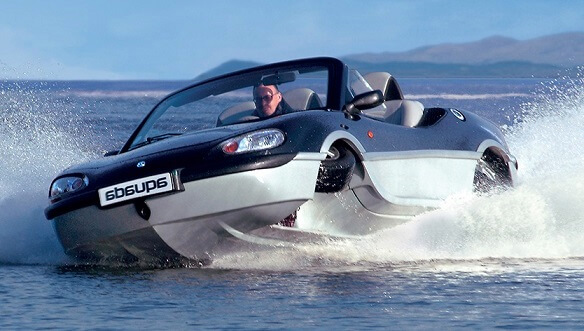
On this machine, Richard Branson crossed the English Channel in 2004 in 1 hour and 40 minutes.
After such a demonstration of the capabilities of a modern amphibian, the question arises involuntarily – “And what prevents the massive use of such machines?”
The fact is that before, the ability to move amphibious cars through the water was seriously limited by the shape of the body, and the necessary design compromises because of the engine that affected the cost and resource of the car, and with a small series also increased the price for the car.
This was sometimes solved by “hybridization”. This meant that there were a separate electric motor and a battery that worked when driving on water, but there was an internal combustion engine for sushi and auxiliary functions. Nowadays, purely electric concepts of mass floating electric vehicles have already appeared.
For example electric semi-amphibious One.
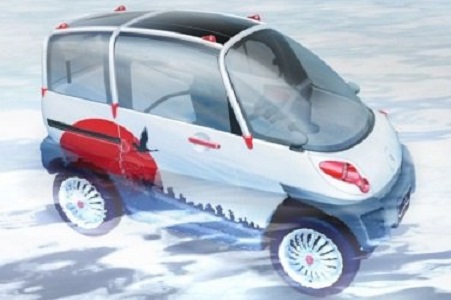
This electric car plans to release a former employee of Toyota.
The reason for creating this water-earth electric vehicle is no less interesting than its characteristics.
So Hideo Tsurumaki, having witnessed many tragic incidents caused by Tsunami, quit his job in the ranks of Toyota Corporation, and decided to create a floating electric vehicle (let me remind you for those who do not know – in Japanese society it’s not customary to give up work in corporations, as it is, and leaving it is not welcome).
In 2012, Tsurumaki founded the company “Fomm Corp.”, the purpose of which was to create this urban waterproof car on electric, which could ride in shallow waters and even swim.
Having on hand less than $ 2,000, in the absence of production capacity and human resources, for several years in the dorm room Tsurumaki himself built the first prototype of such a car. In the end, he created a tiny four-seater electric car Fomm that looks like a golf car.
Of course, this small vehicle is not able to withstand the fierce tsunami waves, but it is the first electric car in the world, able to move quickly on the water.
Tsurumaki did not calm down on one prototype and has already built the fourth prototype of his floating electric vehicle, which he calls the amphibian electric car with the ability to travel by land and water.
Thanks to four replaceable batteries, on one charge it is able to travel 160 kilometers, developing a maximum speed on the land of 80 km/h, on the water – 20 km/h.
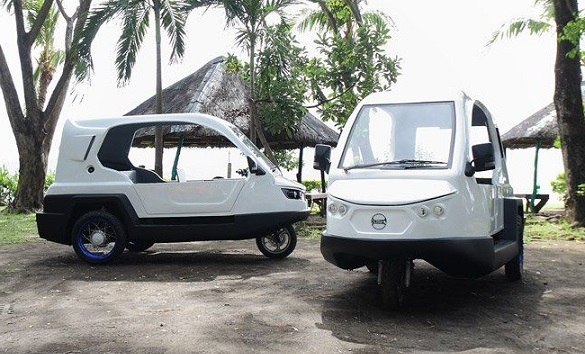
The Philippine company H2O Technologies is planning to launch an amphibious motor rickshaw in a series called Salamander. The engine of this amphibian can be both electric and gasoline.
In Europe, there is a company specializing in the production of amphibians, which made the watercraft Toyota Land Cruiser.
The potential of the “classics” of two-sided machines is in general clear, but there are other options for solving the issue of water travel.
For example on hydrofoils.

Back in 1963, designer R.E. Alekseev (the creator of the passenger ships “Rocket”, “Meteor”) experimented with the creation of an easy floating hydrofoil vehicle. The design for such a machine was borrowed mainly from the conventional NAMI-055 machine. “Winged” amphibian received the designation NAMI 055V.
The main goal of this machine was to reduce the resistance to the movement of the amphibian due to a partial or full lifting of the hull and wheels above the water surface.
Tests of the finished sample took place on the Volga, where the car showed a speed of 58 km / h after 35-40 seconds from the beginning of the movement. The success of this amphibian was recognized, but the car did not go into the series since the re-equipment process turned out to be too long and labor-intensive, which was in no way suitable for the military.
NAMI 055B entered the history as the first and only light military amphibian on hydrofoils.

The civilian version of the car with hydrofoils was created in 2004 by the Swiss design studio Rinspeed.
Double roadster – Rinspeed Splash.
Characteristics of amphibians are impressive.
- The speed on the water – 83 km/h.
- Speed on land – up to 200 km/h (acceleration to 100 km/h in 5.9 seconds.)
- Splash weight – 825 kg.
After 4 years, Rinspeed has already presented a car that could move under water.

Rinspeed sQuba.
Underwater, the concept was set in motion with two screws under the rear bumper and side swiveling water cannons in the front. With an open design, the water completely fills the cabin, and therefore, for breathing, the driver and the passenger wore a mask with a scuba tube, which was fed from an onboard air balloon (is it really similar to the concept of the Mask air cylinder?)
It should be noted that the concept of a car-submarine, in this case, is not the only option in history. There were like passenger “auto-submarines” of the 20th century, so even “underwater” tanks of the original design for crossing shallow water barriers.

The so-called underwater walking tanks were a concept designed to solve the problem of the need for bridges and crossings. The depth of immersion, in this case, did not exceed 5 meters and the range of the underwater course to 700 meters.
Time to prepare the tank to overcome the water obstacles took from 15 to 40 minutes.
There was also an express solution for the T-80U and T-80UD tanks, where it was possible to install the ford system, which allowed us to overcome a water barrier of no more than 1.8 m depth without preparation
Scuba diving, however, is not limited to Tanks only. Armored personnel carriers and any other heavy machinery with sufficient retrofit can also “walk along the bottom” a little without consequences.
Maybe we should in the future apply a similar system for civilian purposes?
The principle of the air duct has been known since ancient times, and most likely will not lose its relevance in our time. All the same, drag a heavy tank to the bottom of the depth of the dive is not very reasonable (especially since the strength of the “submarine” is also limited).
Partly the idea of a pipe for air is implemented in jeeps for off-road.
Snorkel on the body just performs the function of air intake when immersed in water …
Therefore, in the case of an electric car, it will be enough just to make it flexible and foldable for underwater traffic.
From the waterfowl projects of the machines can be identified and “conditionally waterfowl.”
The 1960s American hovercraft flying car was outwardly very strange …
GAZ-16A is more constructively logical than the “American,” but didn’t go further than the tests.
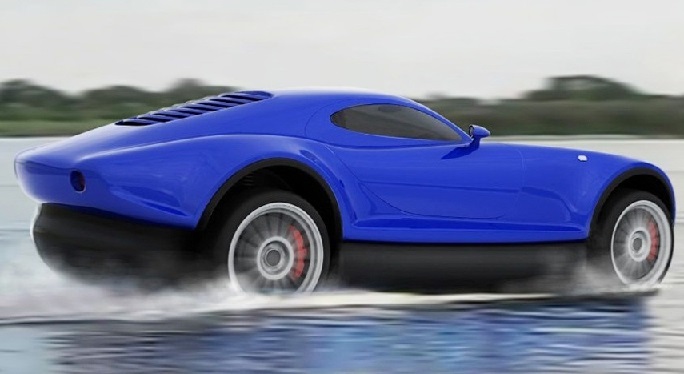
And now, in our time, technology has a chance to survive the “reincarnation” in electro-style.
So in the company, Yagalet is working on the creation of a sports electric roadster with an air cushion under the bottom, similar to those using a hovercraft. Engineers from the Samara region are working on the implementation of this idea, and the ultimate goal is to create a car that can move “on any type of surface”.
- The cushion will allow the Russian roadster to successfully overcome water obstacles, and the driver will not need a pilot’s license to control it. The roadster body will be made of composite materials for weight reduction, and the power plant will be electric.
Certainly, such a device will not be entirely correct for a waterfowl, since it still flies (albeit very low), but these flights mostly take place in practice over water.
From all of the above, you can make a simple conclusion – to consider the prospect of electric transport as a whole as a continuation of the traditional automotive concept is wrong. This is a common mistake of “predictors” to attach old methods of use to the new type of technology based on experience, but not on the logic and potential of technology.
- Such errors were before. So at the beginning of the 20th century, there were opinions about the nascent motor transport as too noisy, complicated and often breaking mechanism with a specific “feed” that needs to be bought at the pharmacy (does it remind stories about the impossibility of electric transport because of the large number of charges?).
Nevertheless, Cecilia Berta Bentz took her husband’s car without asking her, made a journey on her that dispelled many doubts (Imagine how then Karl cursed without seeing his car at home?). By the way, Berta’s journey was not as comfortable as it is now, and she even had to master some methods of express repair.
At that time, the steam engine was considered more promising because of omnivorous, and the electric one, even more, promising because of the simplicity of the design but won the ICE.
History, as we see, took the side of the most “unpromising” direction in the opinion of many logical thinkers at that time, and now a similar process is taking place.
- All thoughts about the prospects, taking into account the old traditions, simply do not take into account the advantages of the technology being introduced, and often consider them irrelevant and unnecessary.
There is already an example with mobile phones in our time. The introduction of camera phones and then smartphones seemed completely unreasonable since the client had a choice of better cameras and cameras on the market for photo and video shooting. Mobile Internet – “Why?” Asked many …
But not much time has passed and the smartphone has become the main “phone”, and the “classic” is a fallback and a sign of Old school.
The same process can occur in electric vehicles. At least technically, the problems here are significantly less than they were at the beginning of the era of internal combustion engines.





